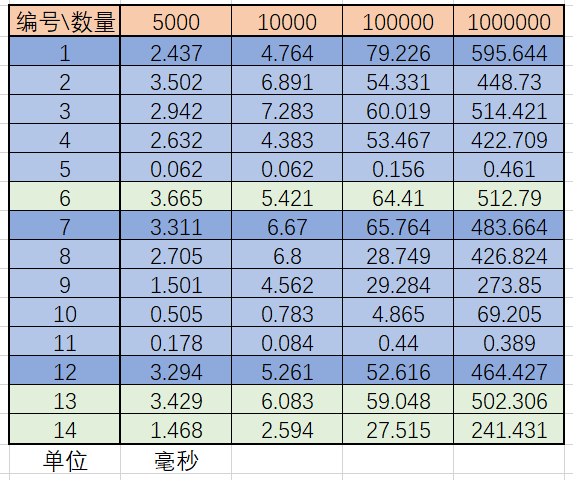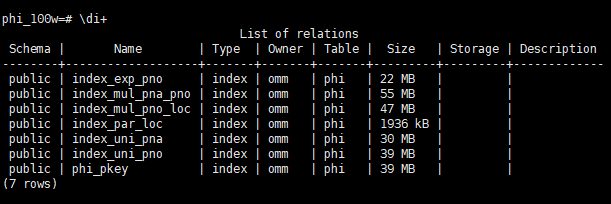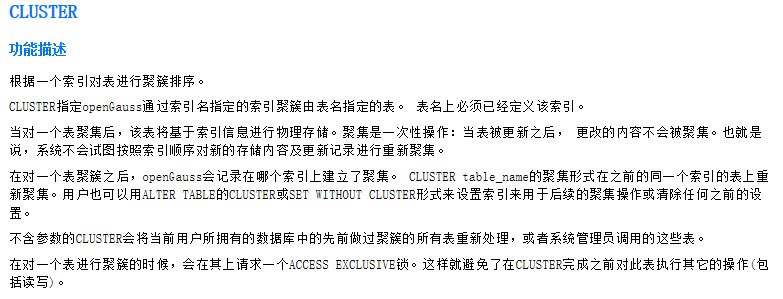建立索引是提高数据库访问速度的重要手段之一。本文将对openGauss2.0.0的4个主要索引方式进行实验,验证建立索引前后查询性能的差异和部分索引规则。
实验环境
软件:openGauss2.0.0, openEuler20.03, VirtualBox6.1.16,虚拟机配置2处理器,4G内存
硬件:CPU: Intel i5-8265U
openGauss索引介绍
根据openGauss2.0.0手册,openGauss有四种索引和根据一个索引对表做一次性聚集操作的CLUSTER语句。
表1 openGauss的4种索引方式(截图自openGauss2.0.0手册《创建和管理索引》章节)
图1 openGauss的CLUSTER语句描述(截图自openGauss2.0.0手册《CLUSTER》章节)
据此可以推测,前3类索引(唯一索引、多字段索引、部分索引)都是在对应的属性(集合)上创建B树的辅助索引,不改变表中条目的物理存储顺序;且这些索引都是稠密的,因为辅助索引均为稠密索引。而CLUSTER就指定一个索引,根据索引排序表的条目,被指定的索引成为聚集索引,其他索引仍为辅助索引。
实验1:索引查询实验
建表和插入数据
建立phi表,有pno, pname, location, healthstatus4个属性,具体建表代码如下。
create table phi(
pno varchar(18) primary key,
pname varchar(20),
location varchar(20),
healthstatus varchar(20));
随后建立函数插入数据。通过随机数函数生成大整数并cast到varchar作为pno主码插入数据。但是如果插入主码相同的数据,会产生错误和回滚,导致之前插入的数据也丢失。因此可以采用以下两种方法。
方案1:查重法。每生成一个新pno,就在已插入的表中的pno中查找有没有重复的。一开始对pgSQL的变量作用域不太熟悉,在微信群中的华为工程师帮忙调试了部分代码,函数可以运行(代码见附录1)。但是复杂度O(n^2),插入10万条数据要超过1小时,插入100万条的时间是无法接受的。
方案2:双随机数法。生成一个18位整型随机数(ran)和另一个12位整型随机数(ran2),令ran-ran2作为pno主码,不进行查重检验,直接插入(代码见附录2)。实际操作中主码重合的概率极低。插入效率大约是每秒钟1万条数据,比较高效。
分别建立了有5000、10000、100000、1000000个数据条目的表进行索引实验。
建立索引
每个数量级的表均会建立5个索引和2次CLUSTER操作。
索引1:建立pno上的普通索引
create index index_uni_pno on phi(pno);
索引2:建立pname上的普通索引
create index index_uni_pna on phi(pname);
索引3:建立(pname,pno)的多值索引
create index index_mul_pna_pno on phi(pname,pno);
索引4:建立部分索引
create index index_par_loc on phi(location)
where location='Shanghai' and healthstatus='Health';
索引5:建立表达式索引
create index index_exp_pno on phi(substr(pno,1,4));
聚集操作1:对pno聚集操作
cluster verbose phi using index_uni_pno;
聚集操作2:对pno,location做聚集操作
create index index_mul_pno_loc on phi(pno,location);
cluster verbose phi using index_mul_pno_loc;
查询执行
每个数量级的表均会执行15条查询语句,查询语句和执行的条件如下。
无索引时,进行如下查询,编号为1-6。
explain analyze select * from phi where pno>'500000000000000000';
explain analyze select * from phi where pname>'p678900000000';
explain analyze select * from phi where pno>'500000000000000000' and pname>'p678900000000';
explain analyze select * from phi where location='Shanghai' and healthstatus='Health';
explain analyze select * from phi where pno like '5678%';
explain analyze select healthstatus,count(*) from phi where location='Shanghai' group by healthstatus;
建立索引1-5后,进行如下查询,编号为7-11。
explain analyze select * from phi where pno>'500000000000000000';
explain analyze select * from phi where pname>'p678900000000';
explain analyze select * from phi where pno>'500000000000000000' and pname>'p678900000000';
explain analyze select * from phi where location='Shanghai' and healthstatus='Health';
explain analyze select * from phi where pno like '5678%';
对pno聚集操作后,进行如下查询,编号为12、13。
explain analyze select * from phi where pno>'500000000000000000';
explain analyze select healthstatus,count(*) from phi where location='Shanghai' group by healthstatus;
对location,pno聚集操作后,进行如下查询,编号14。
explain analyze select healthstatus,count(*) from phi where location='Shanghai' group by healthstatus;
实验结果

表2 各查询语句的执行用时(单位:毫秒)
结论1:对比运行时间1、7、12,查询pno上特定范围的数据。建立pno上的索引后、或者对该索引聚集后,访问pno>’500000000000000000’的速度略微加快;explain analyze显示添加索引后仍是遍历访问。

图2 100万条数据时查询12的结果
结论2:对比运行时间2、8,查询pname上特定范围的数据。建立pname上的索引后,访问pname>’p678900000000’的速度略微加快。同样,explain analyze显示添加索引后对pname仍是遍历访问。
结论3:对比运行时间3、9,查询pno和pname都在特定范围内的数据。建立索引1-5后,查询pname>’p678900000000’ and pno>’500000000000000000’的速度明显加快,基本节省一半时间。但是看explain analyze的信息,发现查询过程是在满足pno条件后用pname的普通索引找的。

图3 100万条数据时查询9的结果
结论4:对比运行时间4、10,查找位于上海的健康人。可以发现使用对应的部分索引可以明显加快访问,因为已经把要的数据建成树了。
结论5:对比运行时间5、11,查找pno开头是5678的人。发现表达式索引作用尚不显著,可能本身用时就比较快。
结论6:对比运行时间6、13、14,该查询要求显示在上海的各healthsatus的人数。显然6是遍历的时间(因为6的用时和1、3接近);13根据pno聚集后,用时小幅缩短;14按(location,pno)聚集后,用时减少超过一半。据此可以从查询策略上猜想,6、13都是遍历;14根据(location,pno)索引准确找到了location=’Shanghai’的位置并只遍历上海的数据,因此最快。
实验2:索引规则实验
表达式索引
表2中编号5和11的查询没有收到预期效果(11应远远快于5)。查询手册发现openGauss要求表达式索引只有在查询时使用与创建时相同的表达式才有效,下面进行验证。
查询指令
select * from phi where substr(pno,1,4)='2345';
分别在无和有索引5的情况下运行(图4、图5),时间分别为0.544ms和848.343ms,可以看到差别巨大。也表明表达式索引在大数据量时非常有用,但使用条件非常苛刻,要求表达式相同。
如果表达式不同(图4、图6),那么在查询执行时就不会用到表达式索引。不过有趣的是不用索引5的运行时间比用索引还短那么一点点。

图4 有索引5时的查询select * from phi where substr(pno,1,4)=‘2345’;

图5 无索引5时的查询select * from phi where substr(pno,1,4)=‘2345’;

图6 有索引5时的查询select * from phi where pno like ‘2345%’;
主键索引
可以看到建表时openGauss默认创建的索引phi_pkey和我创建的在pno上的普通索引index_uni_pno大小一致,猜测他们都是关于pno的普通索引。分别对两个索引进行cluster操作并查看数据,发现两者都是按pno按字典序排列。因此认为openGauss的表的主键索引{tablename}_pkey是建立在表主码上的B树索引。

图7 表的所有索引
附录
附录1:插入数据的函数(查重方法)
create or replace function insert_data(numb integer) returns void
as $$
begin
declare counter integer :=1;
declare ran integer := random()*1000000000 as integer;
declare pn varchar(18) := cast( ran as varchar(18));
declare pna varchar(20) :=concat('p',pn);
declare loc varchar(20) := 'China';
declare hs varchar(20) := 'Health';
TYPE var20_array IS VARRAY(5) OF varchar(20);
loc_arr var20_array := var20_array();
hs_arr var20_array := var20_array();
begin
loc_arr[1] :='Shanghai';
loc_arr[2] :='Beijing';
loc_arr[3] :='Guangzhou';
loc_arr[4] :='Wuhan';
hs_arr[1] :='Health';
hs_arr[2] :='Uncertain';
hs_arr[3] :='Diagnosis';
hs_arr[4] :='Cure';
begin raise notice 'start at %',statement_timestamp(); end;
while counter<=numb
loop
ran := random()*1000000000 as integer;
pn := cast( ran as varchar(18));
begin
while pn in (select pno from phi)
loop
ran := random()*1000000000 as integer;
pn := cast( ran as varchar(18));
end loop;
end;
pna :=concat('p',pn);
ran :=floor(1 + (random() * 4));
loc := loc_arr[ran];
ran :=floor(1 + (random() * 4));
hs := hs_arr[ran];
begin
insert into phi(pno,pname,location,healthstatus) values(pn,pna,loc,hs);
end;
begin
if counter % 1000=0
then
begin raise notice 'counter: % at %',counter, statement_timestamp(); end;
end if;
end;
counter :=counter+1;
end loop;
end;
end;
$$ language plpgsql;
附录2:插入数据的函数(双随机数方法)
create or replace function insert_data2(numb integer) returns void
as $$
begin
declare counter integer :=1;
declare ran bigint := random()*1000000000000000000 as bigint;
declare ran2 bigint := random()*1000000000000 as bigint;
declare pn varchar(18) := cast( ran as varchar(18));
declare pna varchar(20) :=concat('p',pn);
declare loc varchar(20) := 'China';
declare hs varchar(20) := 'Health';
TYPE var20_array IS VARRAY(5) OF varchar(20);
loc_arr var20_array := var20_array();
hs_arr var20_array := var20_array();
begin
loc_arr[1] :='Shanghai';
loc_arr[2] :='Beijing';
loc_arr[3] :='Guangzhou';
loc_arr[4] :='Wuhan';
hs_arr[1] :='Health';
hs_arr[2] :='Uncertain';
hs_arr[3] :='Diagnosis';
hs_arr[4] :='Cure';
begin raise notice 'start at %',statement_timestamp(); end;
while counter<=numb
loop
ran := random()*1000000000000000000 as bigint;
ran2 := random()*1000000000000 as bigint;
ran := ran-ran2;
pna :=concat('p',pn);
pn := cast( ran as varchar(18));
ran :=floor(1 + (random() * 4));
loc := loc_arr[ran];
ran :=floor(1 + (random() * 4));
hs := hs_arr[ran];
begin
insert into phi(pno,pname,location,healthstatus) values(pn,pna,loc,hs);
end;
begin
if counter % 10000=0
then
begin raise notice 'counter: % at %',counter, statement_timestamp(); end;
end if;
end;
counter :=counter+1;
end loop;
end;
end;
$$ language plpgsql;








